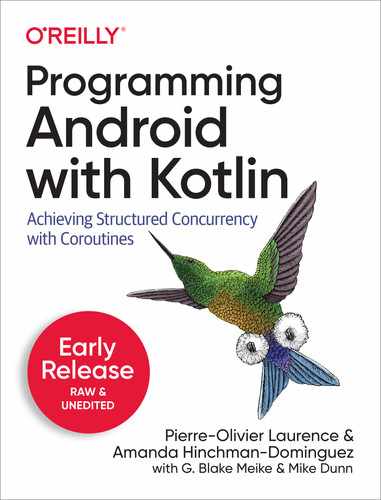Android development is so vast that mastering this mobile operating system can seem daunting--particularly now that Kotlin has become the official Android development language. This book helps Android developers make the transition from Java to Kotlin and shows them how Kotlin provides a true advantage for gaining control over asynchronous computations. By focusing specifically on coroutines, a new asynchronous programming paradigm, this book describes how you can achieve structured concurrency with Kotlin. Authors Pierre-Oliver Laurence, Amanda Hinchman-Dominguez, and Mike Dunn provide implementations of the most common tasks in native Android development.
Table of Contents
- 1. Thread Safety
- 2. Handling Concurrency using callbacks
- 3. Coroutines concepts
- What exactly is a coroutine?
- Your first coroutine
- The async coroutine builder
- A quick detour about Structured Concurrency
- The parent-child relationship in structured concurrency
- CoroutineScope and CoroutineContext
- Suspending functions
- Suspending functions under the hood
- Using coroutines and suspending functions, a practical example
- Don’t be mistaken about the suspend modifier
- Summary
- 4. Structured Concurrency with Coroutines
- Suspending functions
- Traditional approach using java.util.concurrent.ExecutorService
- Using suspending functions and coroutines
- Cancellation
- Coroutine lifecycle
- Cancelling a coroutine
- Cancelling a task delegated to a third-party library
- Coroutines which are cooperative with cancellation
- Handling cancellation
- Causes of cancellation
- Supervision
- supervisorScope builder
- Parallel decomposition
- Exception handling
- Unhandled vs Exposed exceptions
- Exposed exceptions
- Unhandled exceptions
- Summary
- 5. Channels
- Channels overview
- Rendez-vous Channel
- Unlimited Channel
- Conflated Channel
- Buffered Channel
- Channel producers
- Communicating Sequential Processes
- Model and Architecture
- A first implementation
- The select expression
- Putting it all together
- Fan-out and Fan-in
- Performance test
- Back Pressure
- Similarities with the Actor model
- Final thoughts
- Deadlock in CSP
- Limitations of channels
- Channels are hot
- Summary
- 6. Flows
- An introduction to Flows
- Operators
- Terminal operators
- Examples of cold flow usage
- Use case #1: Interface with a callback-based API
- Use-case #2: Concurrently transform a stream of values
- Use case #3: Create a custom operator
- Error handling
- The try/catch block
- The catch operator
- Materialize your exceptions
- Hot flows with SharedFlow
- Using SharedFlow to stream data
- Using SharedFlow as an event-bus
- StateFlow, a specialized SharedFlow
- Summary
- 7. Performance Considerations with Android Profiling Tools
